From the January 2017 issue of DRUM! | By Brad Schlueter
Back in the 1980s, few would have guessed that metal would become the leading genre pushing the envelope of drumming technique. Yet it is, and the reason for this can be summed up in one pattern: the blastbeat.
In the mid ’80s, underground grindcore metal bands created a new and far more abrasive style of metal. Over the ensuing decades, the evolution of these harsher styles, and the musicians who play them, have greatly increased the technical demands of metal drumming, as the speed kept being ratcheted up.
Today’s metal drummers aren’t the chain-smoking, drug-addled, booze swilling stereotypes of the past. Those guys fell by the wayside, largely because they couldn’t keep up with the tempos of modern metal. Over the years, blastbeats continued getting faster, requiring greater technical skills, new methods, and long hours of dedicated practice. Lazy, wasted louts need not apply. Metal’s best drummers now have to be extremely disciplined and surprisingly health conscious, well aware that the demands of their genre are often as physical as they are musical.
Extreme metal combines the sort of physical skills that drumming legends like Buddy Rich might even envy, along with the sort of rhythmic twists and turns that were once the sole province of fusion and progressive rock’s best players. Metal is no longer just about playing loud.
Today’s best metal drummers have looked to the past and re-popularized many methods used by drumming greats — like finger control, open-close, Moeller, and Gladstone techniques, much as the great teachers Jim Chapin and Freddie Gruber did for previous generations — while advocating newer, yet more obscure ones, like freehand sticking technique, and heel-toe
and swiveling bass drum techniques.
You’ll find detailed explanations about the unique sticking and pedaling techniques required to play the following blastbeats at correct tempos on page 44. In addition, each example in this article is based on video performances posted on Youtube by some of the greatest drummers in the genre. Here, we match transcriptions with the accompanying video performances. Ready to blast?
BASIC BLASTS
Traditional/Euro Blastbeat
This is the pattern that started it all. The “original” or traditional blastbeat is a single-stroke roll played between your cymbal and snare, with your kick playing simultaneously with every cymbal hit.
There are many different variations of this pattern, which makes it a little confusing for beginners. The breathtaking speeds at which most metal drummers take blastbeats can make it even more difficult to discern exactly which variation is being played. Good luck figuring out patterns that squeeze something like 20 notes into every second.
Ex. 1: Napalm Death, Mick Harris, “Scum,” Scum (1987)

Mick Harris was one of the first drummers to use these to great effect in his band Napalm Death and every speed metal drummer since has followed in his footsteps. The pattern notated in Ex. 1, excerpted from the song “Scum” by Napalm Death, is the most common and simple to begin with.
Ex. 2: George Kollias, “Traditional Tom Blast,” DVD: Intense Metal Drumming II

Ex. 2 shows George Kollias’ modernization of this groove, taken from his DVD Intense Metal Drumming II. For this one, he uses both kicks alternately playing an “economy” blast, but creatively adds his left-hand floor tom to the pattern for a more intense groove. Earlier in this video clip he demonstrates the pattern using just one kick.
Some drummers play blastbeats open-handed, which means they don’t cross their hands when they blast. Therefore, they lead patterns on the left side of their kit with their left hand and those on the right side with their right hand. Such ambidexterity takes more coordination than when you lead only with your dominant hand, but provides the advantage of keeping your dominant (and faster) hand on the snare when you need to.
Another variation involves inverting the pattern, so it begins with the snare followed by the kick. Also, the cymbal notes can be played on either the snare or the kick in all of these patterns to create additional variations on the traditional blast. Traditional blasts are usually played with just one bass drum, though some drummers alternate their feet when playing these, which is less tiring.
Ex. 3: Derek Roddy, “Fast?”
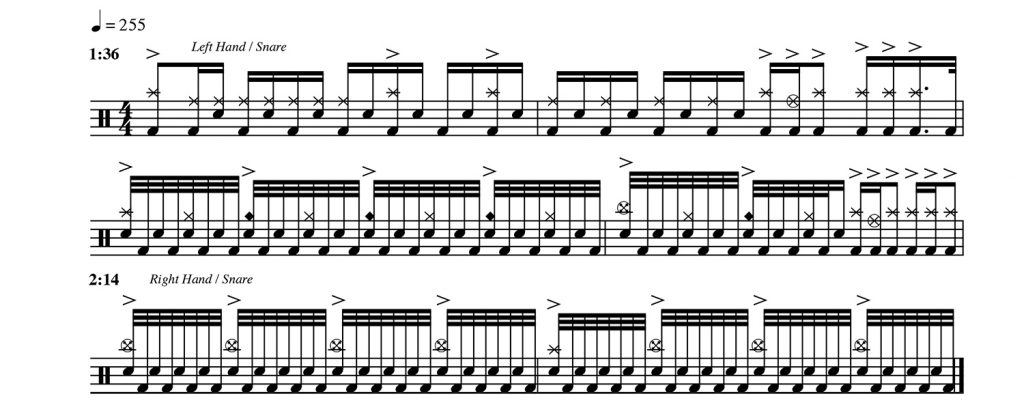
In Ex. 3 — fittingly culled from his video titled “Fast?” — Derek Roddy (Hate Eternal, Nile, Malevolent Creation) uses several of these variations, all while maintaining a traditional single-foot blast. In the first line, we see him begin with his left hand on the snare while playing a sixteenth-note blast, play a short fill, and then invert the pattern to start with his snare, while switching to double-time thirty-second notes. At 2:14, he reverses his hands and plays an open-handed blast that again shows off both his accuracy and speed.
Hammer/Unison/Suffo Blast
Everything hits at once in this version, which creates a relentlessly driving jackhammer blast. To master this one, you must be able to play it with absolutely no flamming between any of your limbs. Practicing this pattern will improve all your other blasts, since any deviation from tight unison hits will be blatantly obvious.
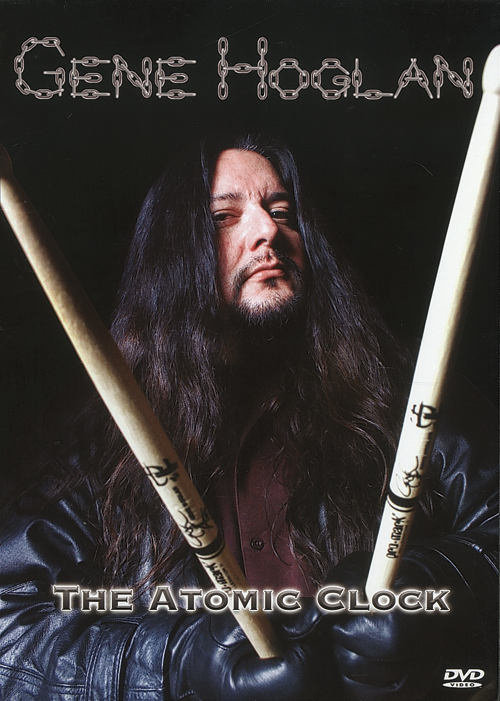
Ex. 4: Hammer Blastbeat, Gene Hoglan, The Atomic Clock DVD, “Siberia”

Ex. 4 comes from the DVD The Atomic Clock by this month’s cover artist, Gene Hoglan. It’s a hammer blast variation played with two kicks, taken from the song “Siberia” by Mechanism. Here, Hoglan demonstrates one of his craziest and most musical blasts, in which his phrasing follows the song’s guitar riffs. Since he plays open-handed and often ambidextrously, he leads with his left foot as his left hand moves between the China cymbal and tom, and his right hand stays planted on his snare. He also plays this quite loudly, making the most of his extended stick heights.
Check out the video and you’ll see Hoglan remarkably plays this blast while wearing ankle weights! They look like five-pounders, too. Why? Probably just to slow down this speed demon.
Bomb/Cannibal Blast
This is essentially a traditional blast with double-time double bass underneath — except that the snare usually begins the blast. The easiest way to play this pattern is to put your right hand on the snare and left hand on the hi-hat. This way your right hand and right kick line up, and your left hand can play the hi-hat notes in between. Sound simple? Just try playing it at 175 bpm!
Ex. 5: Bomb or “Cannibal” Blast, Paul Mazurkiewicz, Cannibal Corpse, “Pit Of Zombies”

Paul Mazurkiewicz used these to great effect with Cannibal Corpse, and Ex. 5 is taken from the band’s song “Pit of Zombies.” Here, he demonstrates a common variation with the snare and hi-hat played together on all the downbeats. You could also think of this as a hammer blast with double-time feet.
SPECIALTY BLASTS
“Dirk” Blast
Ex. 6: The “Dirk” Blast, Dirk Verbeuren
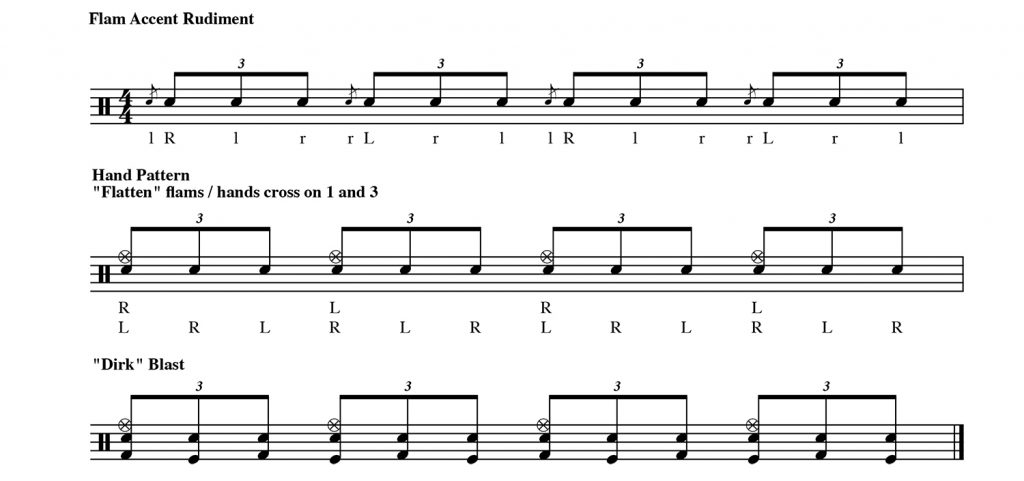
A signature groove of extreme metal drummer Dirk Verbeuren, Ex. 6 is one of the only triplet-based blasts in this article, and a good pattern to know if you ever need it. It’s based on the flam accent rudiment — you remember those, don’t you? (We notated it above the blast, just in case you need a refresher.) The tricky part is crossing your hands on counts 1 and 3 to hit the hi-hat while keeping everything in sync.
Push-Pull Blast
Ex. 7: Push-Pull Blastbeat, Marc Schuhmann, Retaliation, “Defeated Purity”

The groove in Ex. 7 is excerpted from Marc Schuhmann’s drum part on the song “Defeated Purity” by Retaliation, and demonstrates an important sticking technique often used to play blastbeats. The “push-pull” technique uses your thumb and fingers to push the stick forward and backward, letting you play notes quickly with one hand.
The awesome thing is how fast Schuhmann can use the push-pull technique to play this traditional double bass blastbeat.
Heel-Toe Blasts
We’re going to look at two different ways of using the heel-toe technique, which lets you play two bass drum notes from one upstroke/downstroke motion. Once mastered, this method enables drummers to execute some very creative mixed rhythms, not unlike the effect bouncing doubles has on snare drumming.
Ex. 8: Heel-Toe Double-Stroke Blastbeat, Jordan Perry, Derelict, “Perpetuation”

In Ex. 8 we find Jordan Perry playing some fast heel-toe double strokes on song “Perpetuation” by Derelict. A new take on the bomb blast, Perry plays quarters on his hi-hat with his left hand and eighths on his snare with his right. Each hi-hat note is played with a heel stroke followed by a toe stroke.
Ex. 9: Heel-Toe Single-Stroke Bomb Blastbeat, Morgan Van Helsing, “Strange Double Bass Foot Technique Explained”

The next version in Ex. 9 is Morgan Van Helsing’s advanced heel-toe modernization of the bomb blast. Rather than play alternating double strokes (Right Heel–Right Toe/Left Heel–Left Toe) he interweaves them (Right Heel–Left Heel/Right Toe–Left Toe). Though he seems comfortable playing these at absolutely ridiculous speeds, it’s actually very hard to play at fast tempos, since each stroke must be perfectly timed. Turn to page 48 for a lesson on how to pull off this technique.
Swiveling Foot Bomb Blast
Ex. 10: George Kollias, Swiveling Foot Blast

We check in with George Kollias again for Ex. 10, to demonstrate the swiveling foot motion he uses at faster tempos in his DVD Intense Metal Drumming II. By swiveling his feet back and forth (i.e., varying the horizontal angle of his foot in relation to the batter head), the muscle is taxed less than it is when playing in a set position. In the video, he demonstrates a creative way to approach blastbeats: His left hand plays quarter-notes on a second snare and upbeats on his hi-hat, while he plays improvised snare rhythms with his right.
Gravity/Freehand Blast
This blast features the freehand technique on the snare with simultaneous double bass underneath. The freehand technique uses the snare drum’s rim as a fulcrum and lets drummers play two notes during each up and down cycle. It was first popularized by jazz-fusion drummer Kenwood Dennard, but has since been perfected by Johnny Rabb, whose appropriately titled book The Official Freehand Technique is the bible of this skill and covers lots of musical uses far beyond blasting.
Ex. 11: Heel-Toe Quadruple-Pedal Gravity Blastbeat, Morgan Sansous, Brutal Death Drummer – Quadruple Pedals

Ex. 11 comes from Brutal Death drummer Morgan Sansous, and is especially mind-boggling. In his Youtube video, “Quadruple Pedal Gravity Blast Beat,” Sansous demonstrates the use of two Sonor Giant Step Twin Effect pedals for metal drumming. Twin Effect pedals have two beaters, one of which is played by a heel stroke on the rear lever mechanism, and the other played with the toe on the footboard.
Fasten your seat belts. Sansous can apparently reach speeds of 600 bpm using all four pedals at once. In the clip, he plays single-footed sextuplets somewhere around 160 bpm, which is equivalent to straight sixteenth-notes at 240 bpm (with one foot!). On top of this, he plays a left-handed gravity blast at the same speed, making this a very intense version of a hammer blast. I’ve indicated his down (D) and up (U) hand motions and heel (H) and toe (T) motions below the notation.
For Further Study
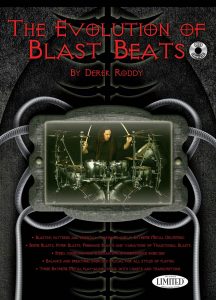
If this introduction to the topic has whetted your appetite, more detailed information on blasting, as well as exercises to develop these skills, can be found in Derek Roddy’s superb book The Evolution Of Blast Beats and his Blast Beats Evolved DVD, as well as George Kollias’ DVDs Intense Metal Drumming, Volumes I and II.
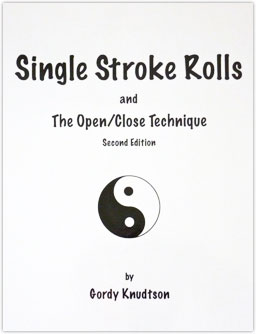
Many metal drummers use Gordy Knudtson’s book and video, Single Stroke Rolls and The Open/Close Technique, and Jojo Mayer’s Secret Weapons For The Modern Drummer details a variety of other tricky hand techniques to learn.
